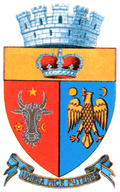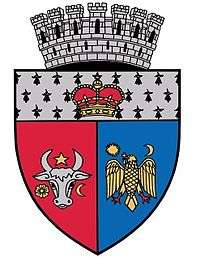Focșani
| Focșani | ||
|---|---|---|
|
Union Square | ||
| ||
 Location of Focșani | ||
| Coordinates: 45°42′0″N 27°10′47″E / 45.70000°N 27.17972°ECoordinates: 45°42′0″N 27°10′47″E / 45.70000°N 27.17972°E | ||
| Country |
| |
| County | Vrancea County | |
| Status | County capital | |
| Government | ||
| • Mayor | Cristi Valentin Misăilă (Social Democratic Party) | |
| Area | ||
| • Total | 48.1 km2 (18.6 sq mi) | |
| Population (2011 census)[1] | ||
| • Total | 73,868 | |
| • Density | 1,535/km2 (3,980/sq mi) | |
| Time zone | EET (UTC+2) | |
| • Summer (DST) | EEST (UTC+3) | |
| Climate | Cfb | |
| Website | http://www.focsani.info/ | |
Focșani (Romanian pronunciation: [fokˈʃanʲ]; German: Fokschan; Hungarian: Foksány; Turkish: Fokşan) is the capital city of Vrancea County in Romania on the shores the Milcov River, in the historical region of Moldavia. It has a population (as of 2011) of 73,868.
Geography
Focșani lies at a point of convergence for tectonic geologic faults, which raises the risk of earthquakes in the vicinity. Though Vrancea county is one of the most popular wine-producing regions in Romania, Odobești being just to the northwest, in Romania, Focșani itself is not considered a wine-producing center. The wine sold as Weisse von Fokshan in Germany and some other European countries is generally a Fetească Albă de Odobești wine, and practically a second-rated wine which does not comply to the European Union rules of naming the regions of origin of wines.
The vicinity is rich in minerals such as iron, copper, coal, and petroleum.
The city administers two villages, Mândrești-Moldova and Mândrești-Munteni.
History
As a town on the Moldavian-Wallachian border, Focșani developed into an important trade center halfway between the Russian Empire and the Balkans. A congress between Imperial Russian and Ottoman diplomats took place near the city in 1772. Nearby the town, the Ottomans suffered a severe defeat at the hands of the allied forces of the Habsburg Monarchy under Prince Frederick Josias of Saxe-Coburg-Saalfeld and Imperial Russia under Alexander Suvorov in 1789 (see Battle of Focșani).
In the 1850s (after the Crimean War), Focșani grew in importance as the center of activities in favor of the union between Wallachia and Moldavia (the Danubian Principalities), leading to the double election of Alexandru Ioan Cuza in Iași and Bucharest. Following this, it housed a Central Commission regulating the common legislation of the two countries, as well as the High Court of Justice. Both institutions were disestablished in 1864, when the Romanian Principality was founded as a unified state. Focșani's role in the forming of the modern Romanian state is immortalized in the Union Square Obelisk.
On 30–31 December 1881, following the impact of Zionism on the Romanian Jewish community, the First Congress of all Zionist Unions in Romania for the promotion of the colonization of Eretz Israel was held at Focșani. It was attended by 51 delegates, representing 32 organizations, two press editors, three newspaper reporters and important guests. This 1881 Congress, the first ever held, 16 years before the World Zionist Organization's First Zionist (held in Basel), had a major influence on the Romanian Jews, and its proceedings also became known outside the borders of Romania.
In 1917, during the Romanian Campaign of World War I, Focșani and Galați were part of a line of fortifications known as the Siret Line. The Armistice of Focșani was signed in the city on 9 December 1917, between the Kingdom of Romania and the Central Powers.
In 1944, during World War II, Focșani was supposed to be part of the fortified Focșani-Nămoloasa-Galați line, where 9 elite divisions were preparing to resist the Soviet Red Army's advance after the Battle of Târgul Frumos. However, due to the turn of events on 23 August 1944 (see Romania during World War II), this never materialized.
Demographics
| Historical population | ||
|---|---|---|
| Year | Pop. | ±% |
| 1912 | 25,066 | — |
| 1930 | 32,481 | +29.6% |
| 1948 | 27,960 | −13.9% |
| 1956 | 28,244 | +1.0% |
| 1966 | 35,094 | +24.3% |
| 1977 | 56,252 | +60.3% |
| 1992 | 101,335 | +80.1% |
| 2002 | 103,219 | +1.9% |
| 2011 | 73,868 | −28.4% |
| Source: Census data | ||
As of 2011 census data, Focșani has a population of 73,868,[1] a decrease from the figure recorded at the 2002 census, making it the 27th largest city in Romania.
According to the census from 2002, there were 101,854 people living within the city of Focșani.[2] The ethnic makeup was as follows:
- Romanians: 98.68%
- Roma: 1.07%
- Hungarians: 0.05%
- Other: 0.2%
Coat of arms


Focșani's location on the Milcov (the river that divided Wallachia and Moldavia) inspired the design of its coat of arms, which depicts the handshake of two women personifying both principalities as a symbol of the union, with the motto Unirea face puterea ("Unity makes strength").
Natives
- Valentina Ardean-Elisei
- Camil Baltazar
- Răzvan Burleanu
- Constantin C. Giurescu
- Simona Gogîrlă
- Carl Grünberg
- Ion Mincu
- Cilibi Moise
- Alin Moldoveanu
- Anghel Saligny
- Oscar Sager
- Solomon Schechter
- Gheorghe Tattarescu
- Adrian Voinea
International relations
Twin towns — Sister cities
Focșani is twinned with:
-
 Tivoli, Italy
Tivoli, Italy -
 Potenza, Italy
Potenza, Italy -
 's-Hertogenbosch, Netherlands
's-Hertogenbosch, Netherlands -
 Patras, Greece
Patras, Greece -
 Ramat Gan, Israel
Ramat Gan, Israel -
 Berd, Armenia
Berd, Armenia -
 Banja Luka, Bosnia and Herzegovina
Banja Luka, Bosnia and Herzegovina
References
- 1 2 "2011 Census" (in Romanian). INSSE at vranceamedia.ro. February 2, 2012. Retrieved March 12, 2012.
- ↑ "Ethno-demographic Structure of Romania". The Ethnocultural Diversity Resource Center. Retrieved January 2, 2011.
External links
| Wikimedia Commons has media related to Focșani. |
-
 This article incorporates text from a publication now in the public domain: Chisholm, Hugh, ed. (1911). "article name needed". Encyclopædia Britannica (11th ed.). Cambridge University Press.
This article incorporates text from a publication now in the public domain: Chisholm, Hugh, ed. (1911). "article name needed". Encyclopædia Britannica (11th ed.). Cambridge University Press.


